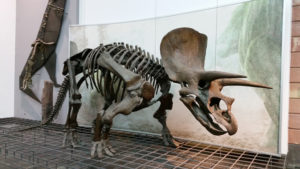Rare Triceratops Fossil Unearthed in Drumheller (Alberta, Canada)
Palaeontologists Excited by Triceratops Discovery
Scientists from the world-famous Royal Tyrrell museum based in the province of Alberta have been expressing their excitement at the discovery of a partial Triceratops fossil skeleton, found just thirty minutes drive from the museum’s doors.
Triceratops Fossil
Triceratops is perhaps one of the most famous of all the dinosaurs. The name means “three-horned face” as this enormous, Late Cretaceous herbivore had two large horns, one over each eye and a third, smaller horn located above the naris. Although there have been a number of Triceratops fossils found in North America, particularly in the American state of Montana (the famous Hell Creek Formation) and in the Canadian province of Saskatchewan, fossils of this particular genus of ceratopsian are extremely rare in Alberta.
Most of the exposed Cretaceous strata in Alberta relate to sediments laid down between 76 million and 70 million years ago (including material from the Campanian faunal stage). Triceratops fossils are found in strata laid down at the very end of the Cretaceous period (Maastrichtian faunal stage). The fossilised bones of this herbivore were first spotted by a former Royal Tyrrell Museum employee whilst exploring a part of the Drumheller Badlands not known for its vertebrate fossils. A team of field workers under the supervision of the Museum’s curator of dinosaur palaeontology Dr Francois Therrien was despatched and after about a fortnights excavation about 30% of the entire fossil skeleton was recovered.
Jumbled Up Bones
The bones of this dinosaur were jumbled up, a result of the remains of this animal being washed into a river and deposited in a slack part of water. When buried, the strata preserved what has been described by scientists as a “log jam of Triceratops bones”. Some of the dorsal vertebrae are an impressive sixty centimetres tall with rib bones although cracked and broken in places, approaching two metres in length. Much of the specimen has already been transported back to the Royal Tyrrell Museum’s preparation laboratories, the fossil bones protected by field jackets made up of burlap and plaster. The largest piece to transport was a single jacket measuring 2.5 metres by 1.3 metres and weighing more than two metric tonnes.
Although the fossil specimen is yet to be formally declared as Triceratops material, Dr Therrien believes that based on the shape and size of the bones and the geological layer in which the fossils were found, it is very likely that what they have discovered relates to this famous genus of horned dinosaur. The Royal Tyrrell Museum may be world-famous for its vast collection of Cretaceous vertebrate fossils, but surprisingly it only has fragmentary Triceratops remains in its collection. With the newly discovered fossil material, the Royal Tyrrell Museum now has the opportunity to study associated bones from a single individual.
A Triceratops Specimen on Display at the Naturmuseum Senckenberg

A cast of a Triceratops skeleton on display at the Naturmuseum Senckenberg (Natural History Museum – Frankfurt). On the left a wall mounted example of a Plateosaurus can be seen.
Picture credit: Everything Dinosaur
Museum staff are keen to start work preparing the fossils in readiness for display. Some of this work can be viewed by visitors to the museum as part of the preparation area of the museum is behind a huge glass fronted viewing area, which allows observers to see the care and dedication required to prepare fossil material for use in exhibits.
For models and replicas of Triceratops and other horned dinosaur figures: Horned Dinosaurs and Other Models (CollectA Deluxe).

